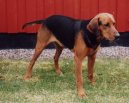Schillerstovare (Dog standard)
Schillerstovare is a well proportioned, sinewy and noble giving impression of speed and strength.
FCI-Standard N°131/ 17.11.97/ GB
SCHILLERSTÖVARE
(Schillerstövare)
TRANSLATION : Renée Sporre-Willes.
ORIGIN : Sweden.
DATE OF PUBLICATION OF THE ORIGINAL VALID STANDARD : 17/07/1997.
UTILIZATION : Scenthound that gives tongue and is used for hunting hare and fox. It is not a pack hound, nor hunted in couples or used for hunting deer.
CLASSIFICATION F.C.I. : Group 6 Scenthounds and related breeds.
Section 1.2 Medium-SIZEd hounds.
With working trial.
BRIEF HISTORICAL SUMMARY : At the first Dog Show in Sweden in 1886 some 189 scent hounds were on exhibition. Among them were a sister and brother, named Tamburini and Ralla I, owned by a farmer, Per Schiller. They descended from famous hounds kept at the Kaflås estate. These hounds were probably descending from Southern Germany, rather small, tan with black mantle and slight white markings. The Schillerstövare was further founded on Swiss hounds and a considerable infusion of British hounds, mainly Harriers. The breed quickly became homogenous in type. The Schillerstövare was recognised as a breed by the Swedish KC in 1907.
GENERAL APPEARANCE : Well proportioned, sinewy and noble giving impression of speed and strength.
IMPORTANT PROPORTIONS : Slightly rectangular BODY.
BEHAVIOUR /TEMPERAMENT : Lively and attentive.
HEAD : Longish HEAD. Seen from both the front and side, the HEAD should be triangular without the muzzle being snipy.
CRANIAL REGION :
Skull : Skull only slightly arched and broadest between the ears.
Stop : Stop well defined.
FACIAL REGION :
Nose : Nose black, with well developed nostrils.
Muzzle : Muzzle long and bridge of nose straight and parallel to line of skull.
Lips : Lips should be tight and closely lying.
Cheeks : Cheeks lean.
Jaw/Teeth : Scissor bite. Teeth strong and well developed.
Eye : Dark brown with lively expression.
Ear : Set high, when drawn forward, ears not to reach half-way along muzzle and may be raised slightly when the dog is attentive. Soft, hanging flat with fore edge lying closely to cheeks.
NECK : Long and powerful, merging nicely into shoulders. SKIN on NECK supple and close fitting. Males should have a well defined arch of the topline.
BODY :
Withers : Withers well defined.
Back : Back level and strong.
Loin : Loins musclar and slightly arched.
Croup : Croup slightly inclined, long and broad.
Chest : Chest deep, long, well developed and reaching elbows. Ribs moderately sprung.
Underline and belly : Belly only slightly tucked up.
TAIL : Set on in line with back. Straight or slightly curved in sabre fashion. Wide at base and tapering towards tip. In length reaches hock. When the dog moves, TAIL preferably not carried above the level of the back.
LIMBS
FOREQUARTERS :
GENERAL APPEARANCE : Strong bone in harmony with the GENERAL APPEARANCE of the dog. When viewed from front forelegs appear straight and parallel.
Shoulder : Shoulder long, muscular and well laid back. Closely lying.
Upper arm : Upper arm long and forming a right angle to shoulder.
Elbow : Elbow set close to BODY and not visible under ribcage.
Pastern (Metacarpus) : Springy and forming slight angle to forearm.
ForeFEET : Oval in shape with well knuckled and tight toes.
HINDQUARTERS :
GENERAL APPEARANCE : Strong and parallel when viewed from behind.
Thigh : Muscles well developed ; thigh broad when viewed from the side.
Stifle : Well angulated.
Hock joint : Well angulated.
Metatarsal : Short, lean and straight.
HindFEET : Like front FEET. Dewclaws undesirable.
GAIT/MOVEMENT : Parallel, strong, and long-reaching.
COAT : Harsh, not too short, lying very close to BODY. On HEAD, ears and front of legs COAT should be short and smooth. Under TAIL and on back of thighs top COAT may be longer.
COLOUR : Tan with well defined black mantle ( blanket) that covers back and sides of NECK, down to sides of trunk and on upper side of TAIL. Slight white markings on chest and toes permissible. Black HAIR mingled in the tan not allowed in adult specimen. Black markings on the cheeks are permissible though.
HEIGHT :
Height at withers : Males : 53-61 cm, ideal SIZE 57 cm (22, 5 ins).
Bitches : 49-57 cm, ideal SIZE 53 cm (21 ins).
FAULTS : Any departure from the foregoing points should be considered a fault and the seriousness with which the fault should be regarded should be in exact proportion to its degree.
Wrong proportions between length of BODY, height at withers and depth of chest.
Lack of masculinity or femininity.
Broad skull, pronounced occiput.
Dish-face.
Over- or undershot mouth, level bite.
Bulgy cheeks.
Light eyes.
Short, steep croup.
TAIL carried above the line of the back.
Obtuse angle between shoulder blade and upper arm.
Restricted hind MOVEMENT.
Undefined mantle with abundant infusions of tan HAIR.
Heavy black mantle that covers chest, sides of trunk, shoulders and thighs.
ELIMINATING FAULTS :
Aggressive or overly shy.
Aloofness.
Pronounced over- or undershot bite.
SIZE outside the maximum and minimum limits.
Any dog clearly showing physical or behavioural abnormalities shall be disqualified.
N.B. : Male animals should have two apparently normal testicles fully descended into the scrotum.
Source: FCI >>> |
